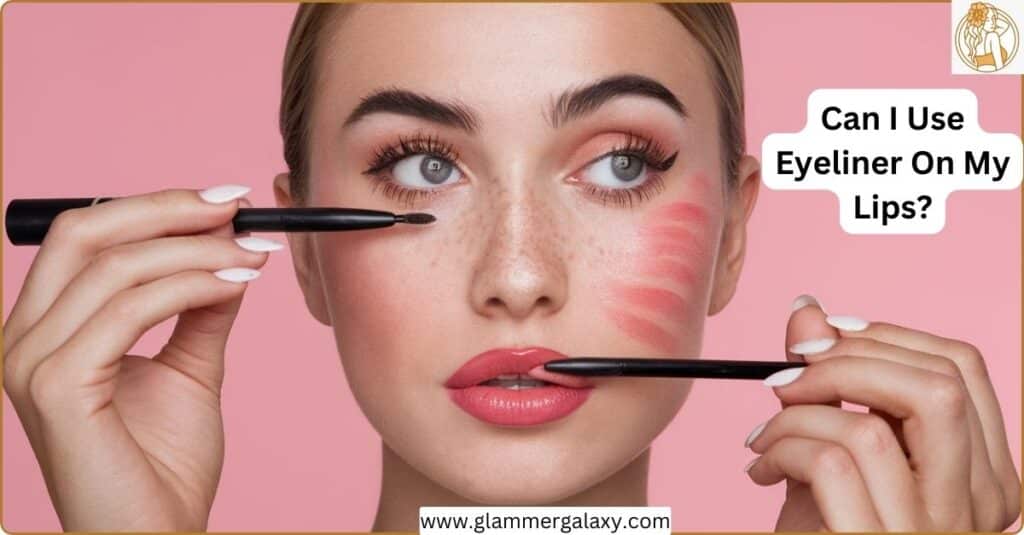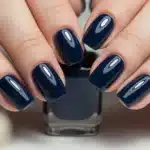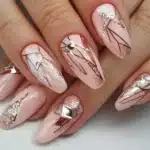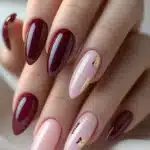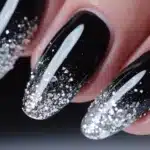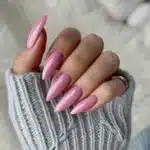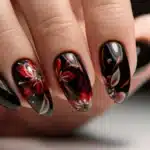Enter the latest buzz: using eyeliner on Lips as lip liner. This unconventional technique has beauty enthusiasts and makeup artists alike buzzing with excitement and curiosity.
A common question that arises is it safe and effective? And most importantly, should you try it? Let’s dive deep into this creative makeup trend and uncover the truth behind using eyeliner on your lips.
The Buzz Around Eyeliner on Lips: A Trend That’s Drawing the Lines
The Origin of the Trend
- Like many beauty trends, the eyeliner-as-lip-liner hack didn’t just appear out of thin air. It’s been lurking in the wings of the makeup world for years, whispered about in backstage dressing rooms and on movie sets.
- It was the influence of social media that really brought this technique into the limelight.
- The roots of this trend can be traced back to the early days of Hollywood, where makeup artists often had to improvise with limited products.
- Legendary makeup artist Max Factor was known for his innovative techniques, including using various products in unconventional ways to achieve desired effects on screen.
Celebrity Influencers: Drawing Attention to Their Lips
Celebrity endorsement can either elevate or diminish the popularity of a look. In the case of using eyeliner on lips, several high-profile names have given the technique their stamp of approval:
- Hailey Bieber: The model and entrepreneur has been spotted sporting a perfectly lined pout, reportedly achieved with eyeliner.
- Kylie Jenner: Known for her lip game, Kylie has hinted at using eyeliner for precise lip lining in some of her tutorials.
- Rihanna: The Fenty Beauty founder is no stranger to makeup innovation and has been rumored to use this trick for her signature bold lip looks.
- Lady Gaga: Always one to push beauty boundaries, Gaga has experimented with eyeliner on lips for some of her more avant-garde looks.
- Zendaya: The young actress has been praised for her daring makeup choices, including the use of unconventional products on her lips.
Social Media: The Catalyst for Viral Beauty Hacks
It’s no secret that platforms like TikTok, Instagram, and YouTube have become breeding grounds for beauty trends. The eyeliner-on-lips hack gained serious traction when beauty influencers started showcasing dramatic before-and-after results. Suddenly, millions of viewers were reaching for their eyeliners, eager to try this seemingly magical technique.
Some notable social media moments that fueled this trend include:
- A viral TikTok video by user @mikaylanogueira showcasing the technique garnered over 5 million views in just 24 hours.
- Instagram makeup artist @nikkie_makeup created a stunning ombre lip look using only black eyeliner and clear gloss, sparking thousands of recreations.
- YouTube beauty influencer James Charles dedicated an entire video to testing various eyeliners as lip products, racking up millions of views and sparking heated discussions in the comments.
The Allure of Eyeliner as Lip Liner: Why Beauty Junkies Are Hooked
Versatility and Cost-Effectiveness: A Makeup Artist’s Dream
One of the main draws of this trend is its sheer versatility. Makeup artists and beauty enthusiasts alike love the idea of getting more bang for their buck.
Why buy separate products when one can do the job of two? This multi-use approach not only saves money but also precious space in your makeup bag.
Consider this: The average eyeliner costs around $20, while a high-end lip liner can run upwards of $30. By using one product for both purposes, you’re potentially saving $30 or more on a single makeup item. For makeup artists who carry extensive kits, this space-saving hack can be a game-changer.
Unique Color Options: Breaking the Lip Color Mold
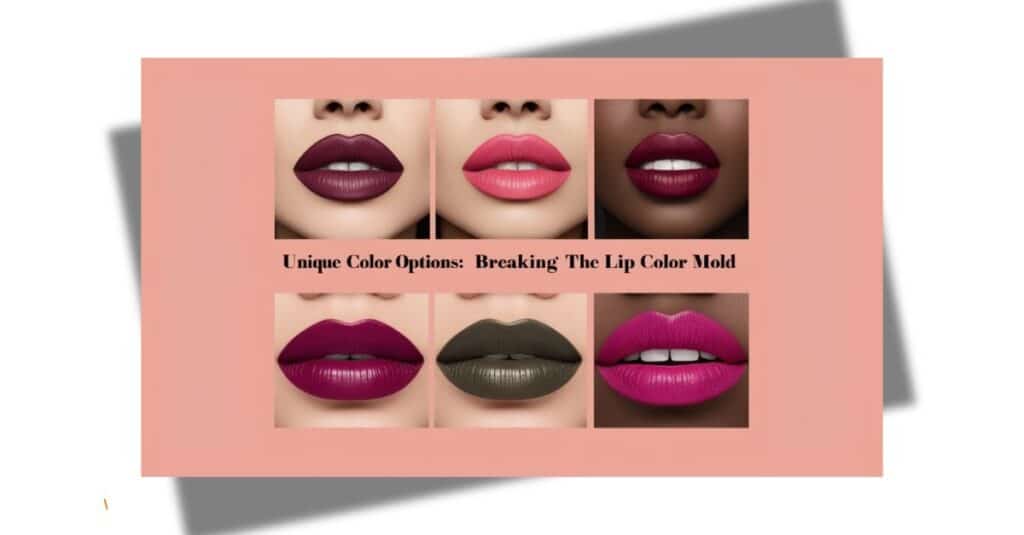
Traditional lip liners often come in a limited range of shades, typically sticking to reds, pinks, and nudes. Eyeliners, on the other hand, offer a rainbow of possibilities.
From electric blues to shimmering golds, using eyeliner on lips opens up a whole new world of color experimentation.
Here’s a quick comparison of color options:
| Product Type | Typical Color Range |
| Lip Liners | Reds, Pinks, Nudes, Browns |
| Eyeliners | Black, Brown, White, Blues, Greens, Purples, Metallics |
This expanded color palette allows for more creative and daring lip looks, perfect for editorial shoots, costume parties, or just everyday self-expression.
Precision and Staying Power: The Holy Grail of Lip Definition
Eyeliners are designed for precision. Their fine tips and long-lasting formulas make them ideal for creating crisp, defined lines that don’t budge. This staying power is particularly appealing for those who want their lip look to last from morning coffee to evening cocktails.
Many eyeliners boast 12+ hour wear times, compared to the average 4-6 hours for traditional lip liners. This longevity is due to the waterproof and smudge-proof formulas often used in eyeliners, which are designed to withstand the natural oils and moisture around the eyes.
See also :
Nail Polish on Ringworm How Fast Does It Work?
Safety First: Can You Really Use Eyeliner on Your Lips?
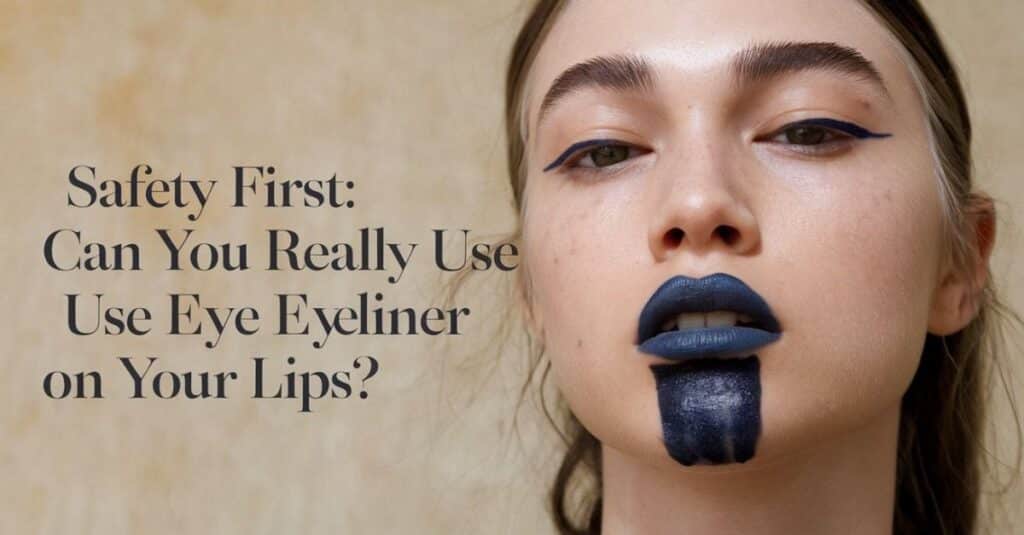
Before you rush to your vanity and start applying eyeliner to your lips, let’s talk safety. After all, your health should always come before any beauty trend.
FDA Regulations on Cosmetic Ingredients
The U.S. Food and Drug Administration (FDA) has strict regulations regarding cosmetic ingredients. It is important to note that the FDA doesn’t approve cosmetic products before they hit the market. Instead they regulate the ingredients used and require proper labeling.
Here’s a quick breakdown of FDA regulations for eye and lip products:
| Product Type | FDA Regulation |
| Eyeliners | Must use approved color additives safe for the eye area |
| Lip Products | Must use approved color additives safe for ingestion |
The FDA maintains a list of color additives approved for use in cosmetics, which is regularly updated. Some additives are approved for general use, while others are restricted to specific areas of the body.
Comparing Eyeliner and Lip Liner Formulations
While eyeliners and lip liners might look similar, their formulations can be quite different:
- Eyeliners: Often contain waxes, oils, and pigments designed to adhere to the delicate eye area without irritation. Common ingredients include:
- Isododecane (for smooth application)
- Iron oxides (for pigmentation)
- Silica (for oil absorption)
- Propylene glycol (as a humectant)
- Lip Liners: Typically formulated with moisturizing ingredients and food-grade pigments safe for ingestion. Common ingredients include:
- Beeswax or carnauba wax (for texture)
- Jojoba oil or vitamin E (for moisturization)
- Mineral pigments (for color)
- Tocopherol (antioxidant)
The key difference? Lip products are made with the assumption that you’ll be ingesting small amounts throughout the day.
Potential Risks and Side Effects
Using eyeliner on your lips isn’t without risks. Some potential issues include:
- Allergic reactions: Your lips are more sensitive than your eyelids therefore may react differently to eyeliner ingredients.
- Dryness and irritation: Eyeliners may lack the moisturizing properties of lip-specific products.
- Ingestion of harmful ingredients: Some eyeliner ingredients aren’t meant to be ingested, even in small amounts.
- Color bleeding: Eyeliners may not be formulated to withstand the moisture and movement of the lips, leading to smudging or bleeding.
- Long-term skin damage: Continued use of non-lip-safe products could potentially lead to premature aging or discoloration of the lip area.
“While using eyeliner on lips can create stunning looks, it’s crucial to prioritize safety. Always check ingredients and choose products that are labeled as multi-use or lip-safe.” – Dr. Sarah Lee, Dermatologist
The Science Behind the Products: What’s Really in Your Makeup?
To truly understand whether using eyeliner on lips is safe, we need to dive into the chemistry of these products.
Common Ingredients in Eyeliners
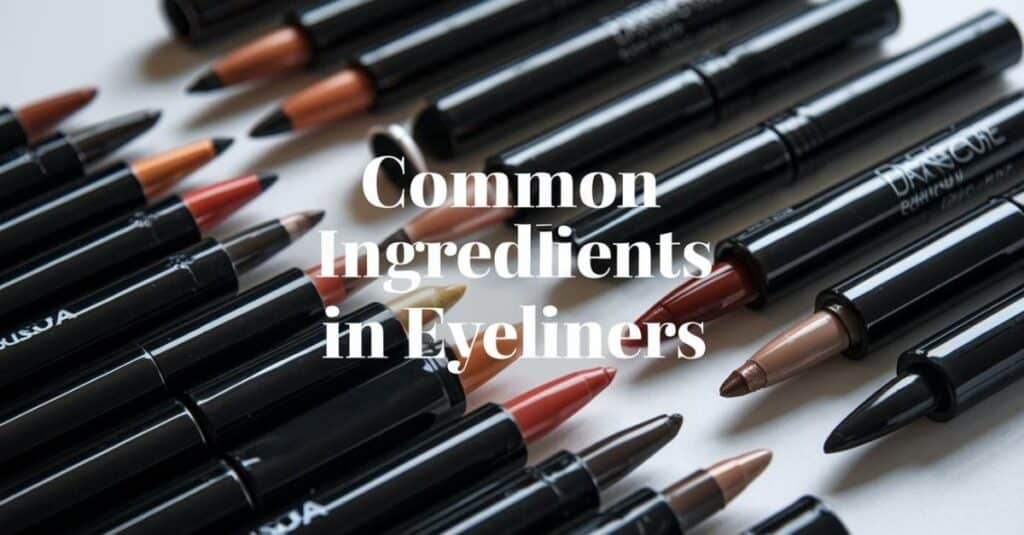
Eyeliners typically contain:
- Pigments: These provide the color. Common pigments include:
- Iron oxides (for blacks and browns)
- Titanium dioxide (for white)
- Ultramarines (for blues)
- Chromium oxides (for greens)
- Waxes: Help with texture and application. Examples include:
- Beeswax
- Carnauba wax
- Microcrystalline wax
- Oils: Aid in smooth application and prevent drying. Common oils are:
- Mineral oil
- Jojoba oil
- Castor oil
- Preservatives: Keep the product fresh and prevent bacterial growth. These might include:
- Parabens
- Phenoxyethanol
- Potassium sorbate
- Film formers: Help the eyeliner adhere to the skin. Examples are:
- VP/Eicosene copolymer
- Acrylates copolymer
Lip-Safe vs. Eye-Safe Ingredients
The main difference between lip-safe and eye-safe ingredients lies in their potential for ingestion:
- Lip-safe ingredients: Must be non-toxic if ingested in small amounts. These often include food-grade waxes, oils, and pigments.
- Eye-safe ingredients: Focus on being non-irritating to the delicate eye area but may not be safe for ingestion. These might include certain preservatives or film-forming agents that are fine on skin but not meant to be consumed.
Understanding Pigments and Dyes Used in Cosmetics
Cosmetic pigments fall into two main categories:
- Organic pigments: Derived from carbon compounds. These include:
- D&C dyes (approved for drugs and cosmetics)
- FD&C dyes (approved for food, drugs, and cosmetics)
- Inorganic pigments: Mineral-based, often metal oxides. Common examples are:
- Iron oxides
- Titanium dioxide
- Zinc oxide
The FDA maintains a list of color additives approved for use in cosmetics, specifying which are safe for the eye area and which are safe for lips. For example, some red dyes (like Red No. 40) are approved for lips but not for use around the eyes.
You might like: Setting Spray Alternatives Unveiling the Hidden Gems
Choosing the Right Eyeliner for Lip Application: A Guide for Beauty Enthusiasts
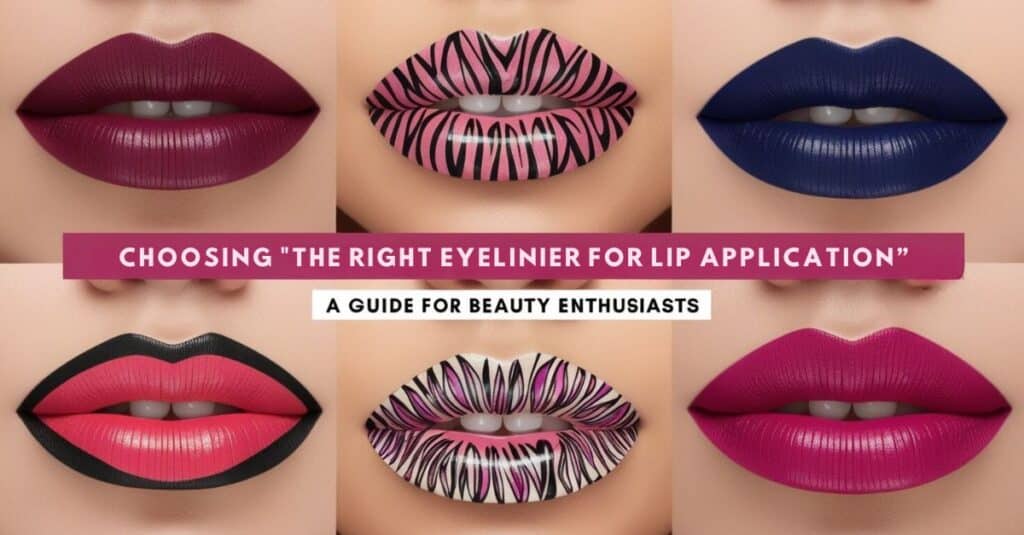
If you’re determined to try this trend, selecting the right product is crucial. Not all eyeliners are created equal, especially when it comes to lip application.
Types of Eyeliners
- Pencil Eyeliners: Often the safest choice for lip use due to their wax-based formulas. They typically contain:
- Waxes (beeswax, carnauba wax)
- Oils (mineral oil, jojoba oil)
- Pigments (iron oxides, titanium dioxide)
- Gel Eyeliners: Can provide intense color but may contain ingredients not suitable for lips. Common ingredients include:
- Silicone-based polymers
- Film-forming agents
- Water-resistant compounds
- Liquid Eyeliners: Often contain alcohol and film-forming agents that can dry out lips. Typical ingredients are:
- Alcohol denat.
- Acrylates copolymer
- Glycerin
Best Formulations for Lip Use
When selecting an eyeliner for your lips, look for:
- Natural, food-grade ingredients: Waxes like beeswax or carnauba wax, and oils like jojoba or castor oil.
- Moisturizing components: Look for vitamin E, shea butter, or coconut oil in the ingredient list.
- Long-wearing formulas: Silicone-based ingredients can help the color stay put without drying out your lips.
- Mineral-based pigments: These are generally considered safer for ingestion than synthetic dyes.
Brands That Offer Multi-Use Products
Some brands have caught on to this trend and now offer products specifically designed for multi-use:
- Kat Von D Beauty: Their Everlasting Lip Liner doubles as an eyeliner.
- NYX Professional Makeup: The Slide On Lip Pencil is marketed for both lips and eyes.
- Bite Beauty: Their Multistick can be used on lips, eyes, and cheeks.
- Milk Makeup: Known for their multi-use makeup crayons that are safe for various areas of the face.
- Glossier: Their Play Color Slide eyeliners are formulated to be gentle enough for use on lips.
When choosing a multi-use product, always check the product description and ingredient list to ensure it’s explicitly stated as safe for lip use.
Step-by-Step Guide: How to Safely Use Eyeliner on Your Lips
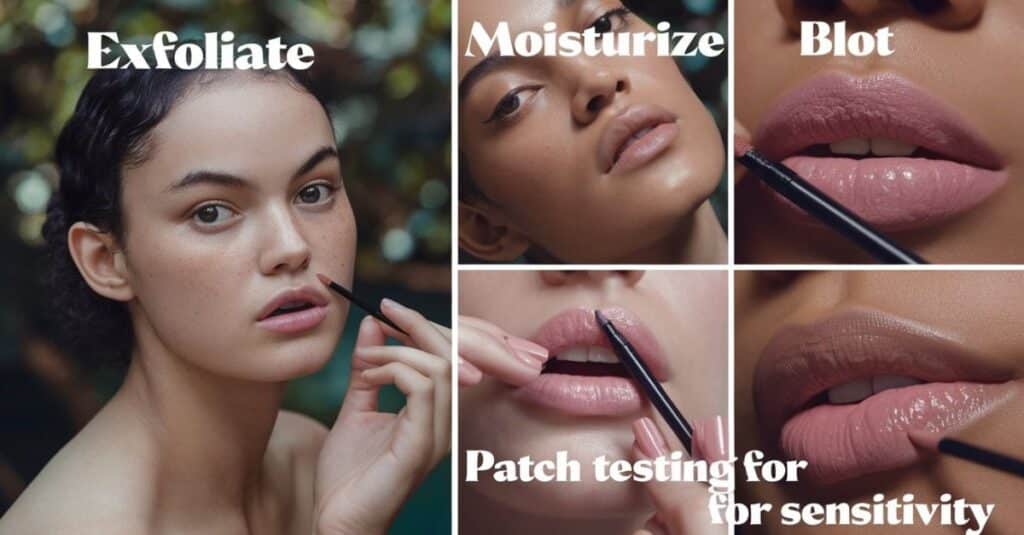
If you’ve decided to take the plunge and try this trend, follow these steps to ensure the best and safest results.
Prepping Your Lips
- Exfoliate: Gently scrub your lips to remove any dead skin. You can use a store-bought lip scrub or make your own with sugar and honey.
- Moisturize: Apply a lip balm and let it absorb for a few minutes. Look for balms with ingredients like shea butter or hyaluronic acid for extra hydration.
- Blot: Remove excess moisture with a tissue. This helps the eyeliner adhere better to your lips.
Patch Testing for Sensitivity
Before applying eyeliner all over your lips, do a patch test:
- Apply a small amount of the eyeliner to the inside of your wrist.
- Wait 24 hours and check for any signs of irritation or allergic reaction. Look for redness, itching, or swelling.
- If there’s no reaction, apply a small amount to the corner of your lip and wait another 24 hours.
Discover more interesting articles:
Toner Turned My Blonde Hair Brown – Causes and Solutions
Application Techniques for Different Eyeliner Types
- Pencil Eyeliner:
- Sharpen the pencil for precision. A sharp tip allows for more control and cleaner lines.
- Start at the cupid’s bow and work your way to the corners. Use short, light strokes for a natural look.
- Fill in the lips if desired. For a fuller look, lightly fill in the entire lip area with the pencil.
- Gel Eyeliner:
- Use a small, angled brush for application. This allows for more precision than the brush that often comes with the product.
- Apply in short, feathery strokes for a natural look. Build up the color gradually for more intensity.
- Set the gel with a matching powder eyeshadow for longer wear.
- Liquid Eyeliner:
- Start with a very thin layer to test how it sets on your lips. Liquid formulas can be tricky on the lips due to their fluidity.
- Build up color gradually to avoid patchiness. Allow each layer to dry before adding more.
- Use a lip brush to blend and soften the edges for a more natural look.
Setting and Sealing the Look
- Set with powder: Lightly dust translucent powder over your lips to set the color. This helps absorb excess oils and increases longevity.
- Apply a lip balm: A thin layer of clear balm can help seal the color and add moisture. Choose a non-glossy balm to maintain the matte look of the eyeliner.
- Consider a setting spray: A makeup setting spray can help lock in your lip color for extended wear.
Removal and Aftercare
- Use a gentle, oil-based makeup remover to take off the eyeliner. Micellar water or coconut oil can be effective and gentle options.
- Gently massage the remover into your lips with a cotton pad or soft cloth.
- Rinse thoroughly with lukewarm water to ensure all product is removed.
- Apply a nourishing lip mask or heavy-duty lip balm overnight to replenish moisture. Look for products containing ingredients like lanolin, shea butter, or hyaluronic acid.
- If you experience any irritation or dryness, give your lips a break from makeup for a few days and focus on hydration.
Expert Opinions: What Makeup Artists Say About This Trend
To get a professional perspective on using eyeliner on lips, we reached out to several renowned makeup artists. Here’s what they had to say:
“I love the versatility of using eyeliner on lips, but I always make sure to use products that are explicitly labeled as safe for both areas. It’s all about being creative while respecting the integrity of the skin.” – Lisa Eldridge, Celebrity Makeup Artist
“The eyeliner-as-lip-liner trick can create some stunning, editorial-worthy looks. However, for everyday wear, I recommend sticking to products formulated specifically for lips.” – Pat McGrath, Legendary Makeup Artist
When using eyeliner on lips, always prioritize the health of your client’s skin. I prefer multi-use products that are specifically formulated for versatility.” – Mario Dedivanovic, Kim Kardashian’s longtime makeup artist
Tips and Tricks from the Pros
- Mix with lip balm: For a softer look, mix your eyeliner with a clear lip balm. This creates a custom lip color while adding moisture.
- Ombre effect: Use a dark eyeliner on the outer edges of your lips and blend inward for a sultry ombre effect. This can create the illusion of fuller lips.
- Create depth: Use a slightly darker eyeliner just in the corners of your mouth to create the illusion of fuller lips. Blend well for a natural look.
- Custom color mixing: Mix different eyeliner shades to create unique, custom lip colors. This works especially well with cream or gel formulas.
- Textured lips: For an avant-garde look, use a glitter eyeliner over a matte base for textured, multi-dimensional lips.
Alternative Products and Techniques
If you’re not comfortable using eyeliner on your lips, consider these alternatives:
- Lip crayons: Often more pigmented than traditional lip liners, these can offer similar precision to eyeliners.
- Matte liquid lipsticks: Can be used to line lips before filling them in, offering both color and definition.
- Brow pencils: Some formulations are safe for lip use and offer precise application. Always check the ingredient list first.
- Eyeshadow as lip color: Use a small brush to apply powder eyeshadow to your lips for a matte, long-lasting effect.
- Cheek stains: Many liquid or cream blushes can double as lip stains, offering a natural, long-wearing color.
DIY Lip-Safe Eyeliner Recipe: For the Bold Beauty Enthusiast
For those who want complete control over their makeup ingredients, here’s a simple recipe for a lip-safe eyeliner:
Ingredients and Tools Needed
- 1 tsp activated charcoal powder (for black) or 1 tsp beetroot powder (for red)
- 1 tsp coconut oil
- 1/2 tsp beeswax pellets
- Small glass jar
- Double boiler or microwave-safe bowl
- Stirring stick or small whisk
- Optional: 2-3 drops of vitamin E oil for added moisture
Step-by-Step Instructions
- Melt the coconut oil and beeswax together in a double boiler or microwave. If using a microwave, heat in 15-second intervals, stirring between each until fully melted.
- Remove from heat and quickly stir in the color powder. Mix thoroughly to ensure no clumps remain.
- If using, add the vitamin E oil and stir to incorporate.
- Pour the mixture into a small glass jar and let it cool completely. This may take 1-2 hours.
- Once cooled, your DIY eyeliner is ready to use. Apply with a small brush or dip a toothpick in to use as a pencil.
Customization Options
- For different colors, experiment with natural pigments like spirulina (green) or turmeric (yellow). Always ensure the pigments are food-grade and safe for cosmetic use.
- Add a drop of peppermint or lavender essential oil for a pleasant scent. Be cautious with essential oils, as some can be irritating to sensitive skin.
- For a more matte finish, increase the ratio of color powder slightly. For a creamier consistency, add more coconut oil.
- Experiment with different waxes like carnauba wax (vegan option) or candelilla wax for varying textures.
The Legality and Ethics of Multi-Use Cosmetics: Navigating the Gray Areas
The trend of using eyeliner on lips raises some interesting questions about cosmetic regulations and consumer responsibility.
Regulatory Standards for Cosmetic Labeling
In the United States, the FDA requires that cosmetics be properly labeled with their intended use. However, many products fall into a gray area:
- “Multi-use” products: Some brands market their products as suitable for multiple areas of the face. These products must meet safety standards for all claimed uses.
- “Not intended” clauses: Many products include disclaimers about uses they’re not intended for. This can protect companies legally but may confuse consumers.
The European Union’s cosmetic regulations are generally stricter, requiring safety assessments for each product before it hits the market.
Read our interesting article about Hair Tinsel on Curly Hair
Consumer Responsibility and Informed Choices
Ultimately, it’s up to consumers to:
- Read labels carefully: Understand what a product is intended for and any warnings it may carry.
- Research ingredients: Familiarize yourself with common cosmetic ingredients and their potential effects.
- Patch test new products: Always test a small area before full application, especially when using a product in a new way.
- Use products as intended by the manufacturer: Deviating from recommended use can pose risks.
- Stay informed about recalls and safety alerts: The FDA and other organizations regularly update consumers about potential hazards.
The Beauty Industry’s Stance on Product Versatility
Many beauty brands are embracing the multi-use trend:
- Fenty Beauty: Offers several products marketed for use on eyes, lips, and cheeks, emphasizing versatility in their product development.
- Glossier: Promotes a minimalist approach with multi-purpose products, aligning with their “skin first, makeup second” philosophy.
- Milk Makeup: Known for their versatile, easy-to-use makeup sticks that can be applied to multiple areas of the face.
- Stila: Their convertible color products are designed for use on both cheeks and lips, promoting a cohesive makeup look.
- RMS Beauty focuses on clean, natural ingredients and creates products that can be used in various ways, appealing to eco-conscious consumers.
This shift towards multi-use products reflects changing consumer preferences for simplicity, value, and reduced environmental impact.
Sustainability Angle: Reducing Beauty Waste Through Multi-Use Products
In an era of increasing environmental awareness, the idea of using one product for multiple purposes is appealing beyond just convenience.
Environmental Impact of Single-Use Products
The beauty industry generates significant waste:
- Packaging waste: Many products come in plastic containers that aren’t easily recyclable. The global cosmetics industry produces over 120 billion units of packaging annually, most of which ends up in landfills.
- Product waste: Unused or expired makeup often ends up in landfills. It’s estimated that up to 30% of beauty products are discarded before being fully used.
- Water usage: The production of beauty products requires significant water resources. A single lipstick can require up to 3 liters of water to produce.
- Carbon footprint: The production, packaging, and transportation of multiple single-use products contribute to higher carbon emissions.
Benefits of Multi-Purpose Makeup Items
Using products like eyeliner for multiple purposes can:
- Reduce overall consumption: Fewer products purchased means less waste generated.
- Minimize packaging waste: Buying one product instead of two or three reduces the amount of packaging entering the waste stream.
- Save resources in production and shipping: Less energy and water are used in manufacturing and transporting fewer products.
- Encourage mindful consumption: Using products in multiple ways can lead to a more thoughtful approach to beauty routines.
- Extend product life: Using a product for multiple purposes can help ensure it’s fully used before expiring.
Tips for Extending the Life of Your Cosmetics
- Store properly: Keep products away from heat and sunlight. Many beauty products are sensitive to temperature fluctuations and can degrade when exposed to direct sunlight.
- Clean regularly: Sanitize pencils and brush applicators to prevent bacterial growth. Use alcohol-based sanitizers for non-porous surfaces and gentle soap for brushes.
- Use within expiration: Pay attention to PAO (Period After Opening) symbols. These indicate how long a product is safe to use after opening.
- Revive dried-out products: Add a drop of facial oil to dried mascaras or gel liners to extend their life.
- Repurpose: Get creative with using up products. You can turn old lipsticks into cream blushes and clean dried-out mascara wands to use them as brow brushes.
- Buy refillable options: When possible, opt for brands that offer refillable packaging to reduce waste.
By adopting these practices and embracing multi-use products, beauty enthusiasts can significantly reduce their environmental impact while still enjoying a diverse and exciting makeup routine.
Give it a read:
FAQs:
Addressing Common Concerns About Using Eyeliner on Lips
As this trend continues to gain traction, many questions arise. Here are answers to some of the most frequently asked questions:
Can you use liquid eyeliner on your lips?
Liquid eyeliners often contain alcohol and other drying ingredients that aren’t ideal for lip use. If you choose to use liquid eyeliner on your lips, opt for ones specifically labeled as multi-use or lip-safe. Water-based formulas are generally gentler than alcohol-based ones.
How do you make eyeliner stay on your lips?
To increase staying power:
- Start with exfoliated, moisturized lips
- Apply a lip primer or a thin layer of foundation
- Set the eyeliner with a matching powder eyeshadow
- Finish with a clear lip sealer or a light dusting of translucent powder
- Avoid oily foods and drinks, and reapply as needed throughout the day
Explore more eyeliner tricks in this video:
Conclusion
Here are our final remarks for using eyeliner on lips as we conclude this article:
- Choose products carefully: Opt for multi-use or lip-safe formulas when possible. Look for brands that prioritize safety and transparency in their ingredient lists.
- Listen to your body: If you experience any irritation, discontinue use immediately. Your skin’s health should always come first.
- Stay informed: Keep up with the latest research and recommendations from beauty experts and dermatologists. The beauty industry is constantly evolving, and new information about ingredient safety emerges regularly.
- Practice good hygiene: Sanitize your products regularly, especially if you’re using them on multiple areas of your face.
- Consider the environmental impact: While experimenting with makeup is fun, be mindful of overconsumption and waste. Multi-use products can be a great way to reduce your beauty footprint.

Sarah Williams is an experienced blogger and fashion enthusiast at Glammer Galaxy. With a passion for beauty and style, she shares expert insights on hair trends, nail art, and fashion tips. Her creative flair and years of experience make her a go-to source for all things glam!

